Top 7 Content Audit Tools for Effective Content Analysis
Written by David L Hicks – May 5th, 2025
It goes without saying that your organization’s content is the most important aspect of your content strategy and workflow. The purpose of your content is to be developed, marketed, and distributed and ultimately reach your intended audience. If you expect your audience to grow, it’s essential to be able to audit and assess it.
Assessing and auditing your content allows your organization to understand what you have and where it needs to go in order to resonate with and grow your audience. For example, an audit can help you identify content that isn’t performing well. Upon discovering the poorly performing content, your organization can decide how to address it.
This is where content audit tools come in. Content audit tools make your organization’s content management team’s lives easier by analyzing and improving your content. Using these tools is a must and something that you should invest in. Through this article, you’ll learn about a content audit, why it’s important, and the seven best content audit tools to choose from. The benefits of content audit tools will be examined in addition to how to maximize their usage when you select one.
Table of Contents
ToggleWhat is a Content Audit?
There is a lot to unpack in terms of a content audit. At its core, a content audit is an assessment of your content. There are several ways to analyze your content:
- Audit of content (written article/blog post)
- Audit of content performance (SEO metrics)
- Audit of content inventory
Content audits are important because they help organizations better understand their current status regarding how their content is performing, how it looks, what content currently exists, and what is missing from their inventory.
The more information organizations have, the better decisions they can make about improving their content. The growth of content audits and their frequency continues, with 54% of marketers conducting content audits at least twice a year.
What is a Content Audit Tool?
A content audit tool is a software platform that helps content developers and marketers analyze, evaluate, and inventory an organization’s content. Although these tools vary by feature, most of them predominately perform the following key tasks:
- Analyzes written content to provide recommendations on how to improve content (i.e., spelling, tone, punctuation, and grammar)
- Crawl websites, blogs, and other content repositories to collect key data points
- Provide visual dashboards that highlight key information, including content gaps and underperforming assets
- Organizes content into structured inventories
Content audit tools are extremely versatile mainly because these tools help in a variety of ways. Case in point: I’ve used Ahrefs in the past for a content audit with an SEO focus, Google Analytics for content performance, and Grammarly to assess how well my content is written. Content audit tools are a worthwhile addition to your content development and content marketing arsenal, especially with other tools, including content strategy tools, content calendar tools, and content analytics tools.
7 Best Content Audit Tools
As you research the best content audit tools, begin with the list of the seven best tools shown below.
1. Google Analytics
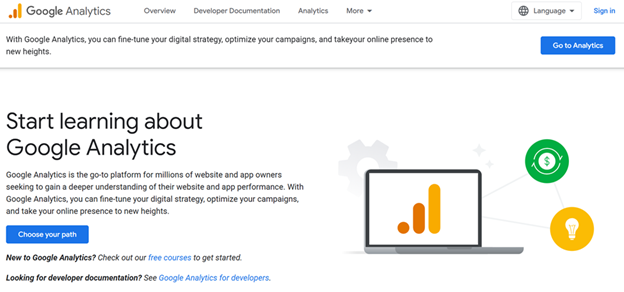
Summary
Google Analytics is a powerful web analytics service offered by Google. The service allows website owners to track and report on website content details. Key website metrics that are collected include clicks, sessions, time on the page, and social media engagement. The information collected by Google Analytics makes analyzing and auditing the information provided easier. You’ll be able to identify high-performing and low-performing content, and based on the results, your organization can decide how to address them.
Pricing Range – Free
Key Features
- Real-time user activity monitoring of site and app activity
- Predictive capabilities
- Content changes and trends insights
- Visitor engagement reports
- Audience segmentation and analysis
Pros
- Free plan
- Offers free education courses
- Ability to import data including the following:
- Custom definitions
- First party data
- Integrations with various Google solutions, including:
- Google Cloud
- Google Ads
- Salesforce Marketing Cloud Integration
- Google Search Console
- Google Ad Manager
- Regular updates and new features (Currently on version GA4)
Cons
- There is a steep learning curve for beginners
2. Screaming Frog

Summary
Screaming Frog SEO Spider is a powerful desktop-based website crawler auditing tool that focuses on technical SEO and content auditing for your entire website. It is an extremely versatile tool that crawls websites to collect comprehensive data about site structure, content elements, and technical SEO issues.
It comes with an extensive list of features that will give organizations enough information to understand their content and website’s SEO performance. Some of these features include finding broken links, duplicate content, and audit scheduling capabilities, making this an extremely valuable tool.
Pricing Range – Free to $259 (Per year)

Important Note – The cost will be $259 per license. The $259 price point will remain at $259 per license as long as the user count remains within four users. The price point per license changes once you pass four users.
Key Features
- Comprehensive website crawling and content inventory
- Broken link finder
- Page title and metadata analysis
- Content audit scheduler
- Spelling and grammar checker
Pros
- Available for the following operating systems:
- Windows
- Mac
- Linux
- Ability to generate XML site map
- Free version available
- Offers user guide
- Offers tutorials and has technical support
- Integration with the following analytics tools:
- Google Search Console
- Google Analytics
- Page Speed Insights
- Ability to find site page redirects
- Ability to configure crawl settings
Cons
- Limited features on the free version
- Steeper learning curve than cloud-based alternatives
- License pricing for each user is expensive
- Limited collaboration features for teams due to high license pricing
- The free plan is restricted to a 500 URL crawl limit
3. Yoast SEO
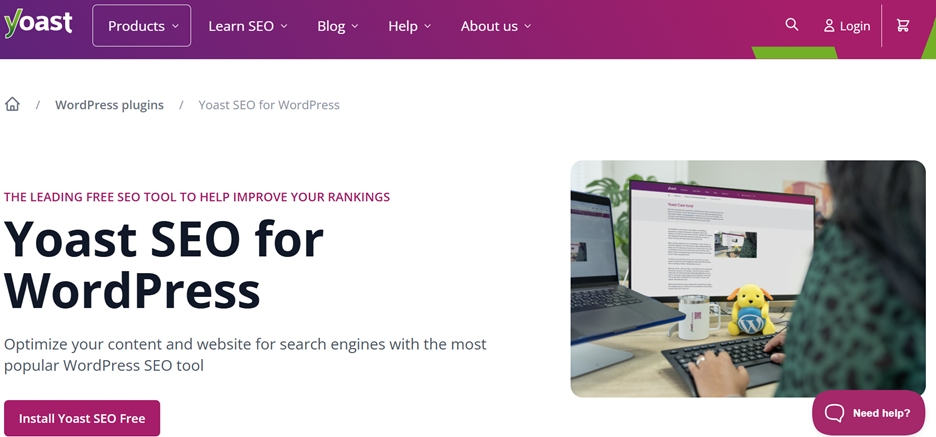
Summary
Another valuable tool, Yoast SEO, is a WordPress plugin that offers content optimization and auditing capabilities. These capabilities are focused on improving search engine visibility. This popular tool provides real-time content analysis and recommendations as you create or edit content. Yoast SEO helps ensure each page follows SEO best practices.
Yoast SEO stands out for its accessibility to non-technical users, which means it’s great for anyone to start up and use. It has a wide variety of features, including real-time content SEO analysis and integration with WordPress and Semrush.
Pricing Range – Free to $99 (Per year)
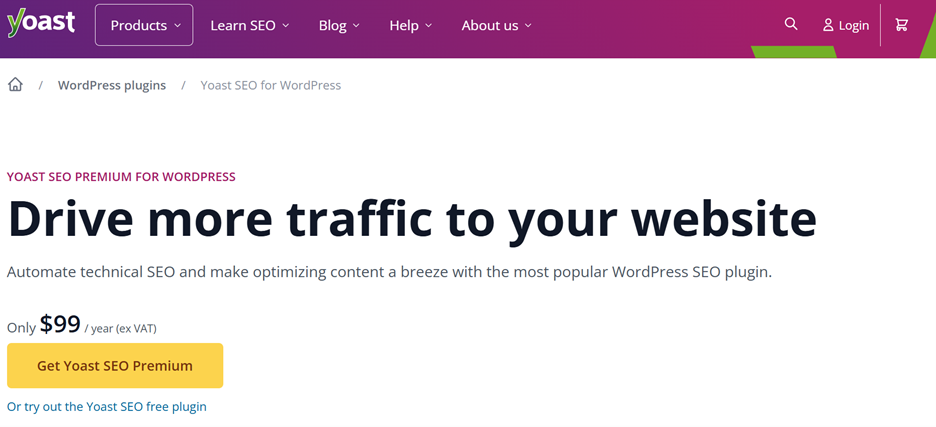
Key Features
- Real-time content SEO analysis and recommendations
- Readability scoring and improvement suggestions
- XML sitemap generation and management
- Internal linking suggestions
- AI optimization capabilities
Pros
- Offers a free version via the plugin
- Seamless integration with the following tools:
- WordPress
- Semrush
- Wincher
- Elementor
- User-friendly interface accessible to non-technical users
- Ability to use Yoast SEO Premium version in the website staging area
- External link recommendations, available in various languages, including the following:
- English
- Spanish
- Polish
- Italian
- French
- Greek
- Japanese
- Redirect finder
- Offers 24/7 user support
- Keyword optimization
- Readability analysis
- Provides meta descriptions
Cons
- Some advanced features require the Premium version
- No content inventory features
- No competitor content analysis capabilities
4. Ahrefs

Summary
Ahrefs is a powerful SEO-centric rank-tracking software tool with many content analytics and reporting features. It offers keyword research functions, website auditing, backlink reporting, and ranking analysis. With all the SEO-centric metrics, it makes auditing your content’s performance easier. At the end of the day, leveraging Ahrefs will help you improve your search engine rankings.
Pricing Range –Free to $1,499 (Per month)
Important Note – The enterprise pricing plan is the most expensive plan within Ahrefs, at $1,499. The enterprise version requires an annual commitment.
Ahrefs – Lite, Standard, and Advanced Pricing Plans
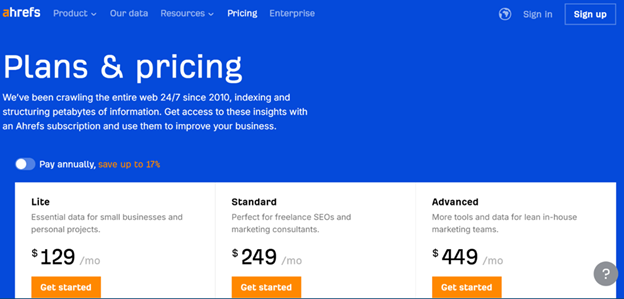
Ahrefs – Free, Starter and Enterprise Pricing Plans
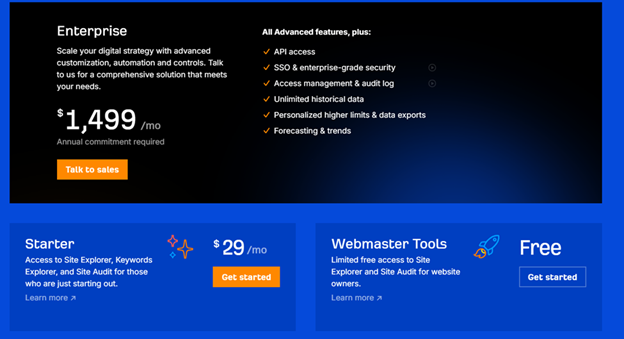
Key Features
- Keyword explorer
- SEO reporting dashboard
- Content gap analysis
- Website rank tracker
- SERP comparison reporting
- Backlink analysis reporting capabilities, including the following:
- Broken backlinks
- Broken links
- Outgoing links
- Link intersect reporting
Pros
- Export reporting capabilities
- Extensive reporting capabilities
- Data can be updated daily (additional price)
- Free tools include:
- Backlink checker
- Website authority checker
- Keyword generator
- Broken link checker
- Website checker
- AI writing tool (includes AI paragraph generator and AI paragraph rewriter)
Cons
- The free version only provides limited access to Site Explorer and Site Audit for website owners.
- Limited credit allotment for Starter and Lite pricing plans
- Limited reporting data to export based on the plan selected
- The enterprise version requires an annual commitment
5. Grammarly
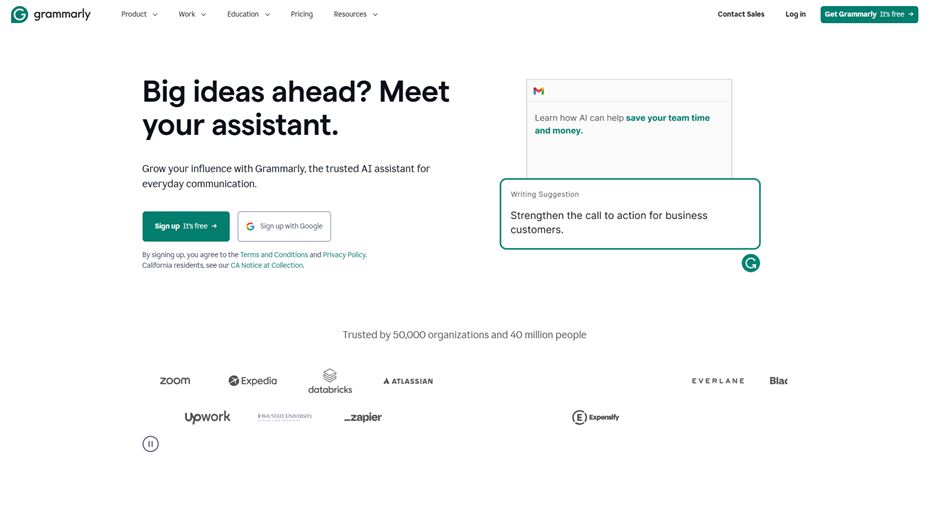
Summary
Grammarly is an AI-based writing assistant. The application helps millions of writers and content developers create clear, concise, error-free, and effective content. This writing tool offers an extensive list of features, including grammar checking, spelling, and punctuation editors.
With Grammarly’s features, your organization can audit and analyze your content in real-time, making for a timely and efficient writing workflow process. Beyond helping with assessing your content, Grammarly provides writing recommendations and allows writers to implement those recommendations in your document.
Pricing Range – Free to $30 (Per month)
Important Note – Pricing range is Free to $12 when paying annually. If you prefer the Enterprise plan you must contact the Grammarly sales team.

Key Features
- Real-time grammar and spelling correction
- Style and tone adjustments
- Plagiarism detection capabilities
- Vocabulary enhancement suggestions
- Proofreading capabilities
Pros
- Produces AI-generated text
- Free version available
- Integration capabilities across multiple platforms, including the following:
- Gmail
- Microsoft Office Products: Word, PowerPoint, Teams, Outlook
- Google Docs
- Apple Mail
- Customizable goals for different writing purposes
- AI detection capabilities
- Provides readability score
- Free grammar checker
Cons
- Advanced features require an Enterprise plan
- May occasionally suggest unnecessary changes
6. SEOptimer
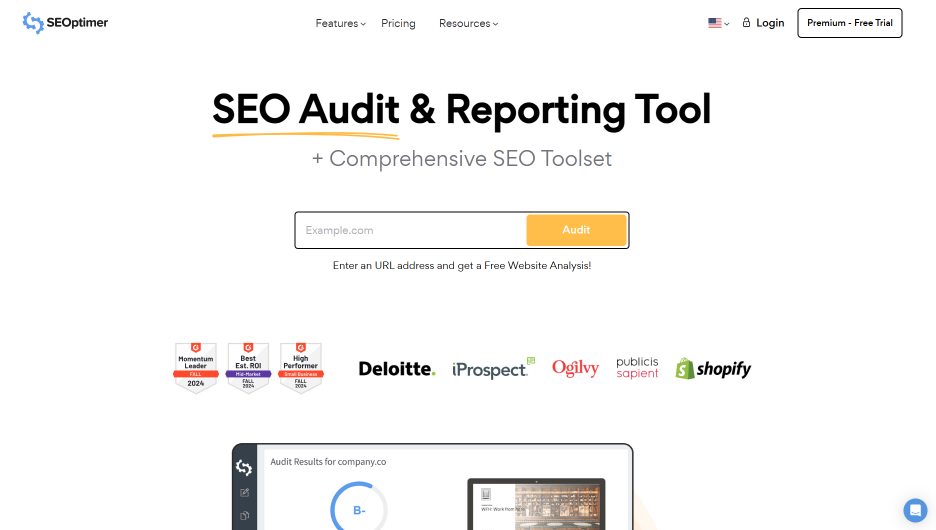
Summary
SEOptimer is a website SEO audit tool that provides extensive, detailed reports on your website. The SEOptimer audit covers over 100 SEO-related items, including on-page SEO, keyword rank, off-page SEO, and backlink profile, which helps you reach your ultimate goal of improving your search rankings and search visibility.
The tool’s assessment of your website is fast and efficient. It provides an easy-to-follow and actionable report with scores and recommendations that help your team implement the recommended changes.
SEOptimer stands out for its user-friendly interface with visually appealing reports that can be easily understood by both technical and non-technical users.
Pricing Range – $29 to $59 (Per month)
Important Note – Although there is no free plan, you can run a free audit report for your website. You are also able to access a free 14-day trial.
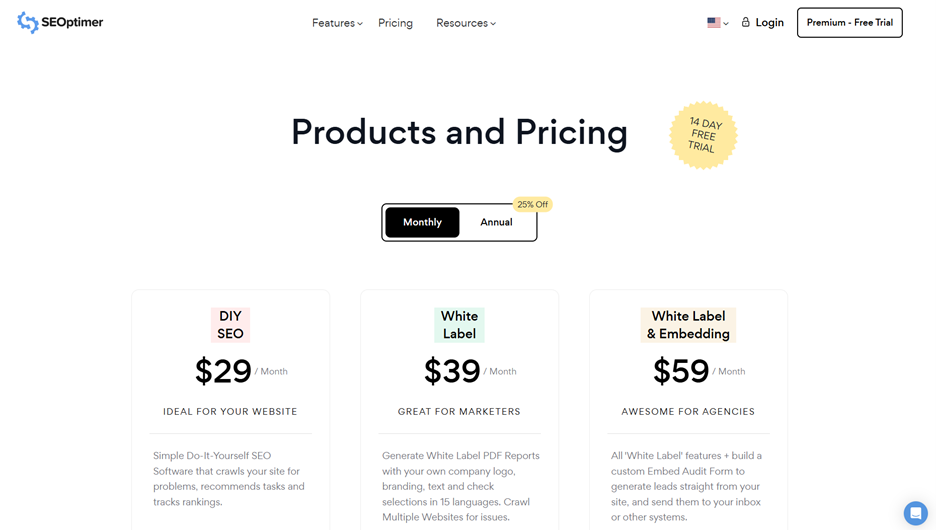
Key Features
- Website audit covering the following five categories:
- SEO
- Usability
- Performance
- Social
- Security
- Keyword tracker
- Backlink tracker
- SEO crawler capabilities
- Competitor tracker
Pros
- Pricing plan inexpensive
- Audit reports are user-friendly and easy to understand (via letter grade scoring system)
- White-label PDF reports come in 15 languages, including the following:
- English
- Spanish
- Italian
- French
- Portuguese
- Polish
- Actionable recommendations prioritized by importance
- Zapier integration
- Lead generator
- Keyword rank tracking
Cons
- Many advanced features only available on the more expensive plans
- Keyword searches are not available on the DIY SEO pricing plan
7. Woorank

Summary
Woorank is another website analysis and SEO audit tool that provides website performance, content quality, and search engine optimization analysis. This user-friendly platform generates detailed reports with actionable insights and recommendations to remediate identified issues. Woorank stands out because it makes complex SEO and content issues accessible to non-technical users. The tool offers both instant site audits and ongoing monitoring to help content developers and marketers identify content gaps, technical problems, and optimization opportunities.
Pricing Range – $89.99 to $199.99 (Per month)
Important Note – If you want the Enterprise plan, you must contact the Woorank sales team.
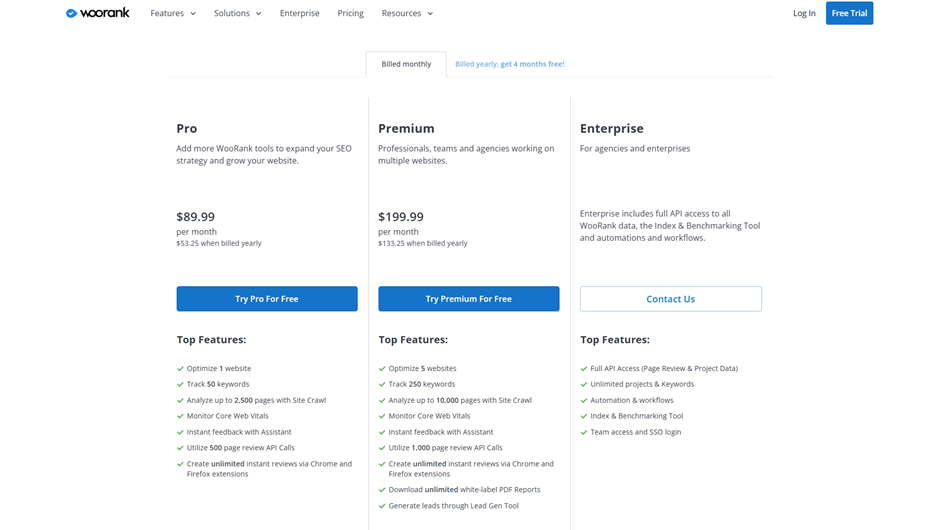
Key Features
- Keyword tracking capabilities, which help with keyword rankings
- Monitor core web vitals
- Ability to create instant reviews
- Ability to generate white-label PDF reports
- Lead Generator
Pros
- Free trial offer
- Website audit reports provide actionable tasks to remediate findings
- Ability to integrate with the following reporting tools:
- Google Analytics
- Google Search Console
- Woorank has a help center and online support with a 24-hour response within a business week
- Comprehensive and easy-to-understand scoring system with visual indicators
- Weekly email updates on website performance
- Competitive analysis capabilities
- Website crawler
- Competitor tracking
- Competitor comparison assessment and reporting
Cons
- Both primary pricing plans (Pro and Premium) are expensive
- No permanent free plan is available
- The pro plan can only optimize one website
Content Audit Tool Benefits
Content audit tools have an extensive list of benefits that help your team. Below is a list of some of the most impactful benefits.
Aligns Content with Current Business Goals
This is perhaps the most important benefit of leveraging an audit tool. Leveraging an audit tool helps your content team evaluate whether your content supports your current priorities and goals. It’s vital that your content aligns with your business goals because if it doesn’t, you’re less likely to succeed.
Improves Decision-Making Process
In my experience, audits provide organizations with clarity. Once an audit has concluded, organizations have a better understanding of where their gaps are. Understanding where your content gaps are helps you understand how the content is written or how it’s performing.
Eliminates Content Waste and Redundancy
Content audits help identify outdated, duplicate, and irrelevant content. Once these issues are identified, organizations can remove, update, or repurpose the content. This will help improve your content inventory; only relevant and optimized content will remain. Having only optimized content helps improve your site’s authority in Google’s eyes.
Improves Search Engine Visibility
Auditing your content from an SEO and technical SEO standpoint will help you identify and address SEO-specific issues with your website. SEO is extremely important to your organization’s website’s content growth. By identifying issues with your metadata, content structure, and on-page SEO, you’ll be able to help optimize your content’s visibility and growth with Google.
Uncovers Hidden Content Opportunities
Finding hidden content opportunities via content gaps is an extremely important benefit. Being able to find gaps and growth opportunities gives your organization the chance to improve its content.
Strategies for Maximizing the Use of Your Content Audit Tool
Getting the most out of your content audit tool is crucial to improving your content and making better decisions.
Schedule Regular Periodic Audits
It helps optimize your content by performing regular audits. The more you use the tool, the more aligned you will be on your content. Larger content teams should shoot for quarterly, while smaller teams and solopreneurs should shoot for bi-annually. The more you use the tool and the more you uncover gaps and areas for improvement, the better decisions your organization will make.
Use Audit Data to Develop Content Governance Guidelines
Leverage the prior audits you performed to create content governance guidelines. Being able to use prior audits to establish standards for content structure, word count, and metadata formatting is essential to developing your governance guidelines. Your constant usage of the audit tool will largely drive the improvement of your content guidelines.
How to Choose the Best Content Audit Tool for You
Deciding the best tools isn’t impossible. If you have a developed criterion to guide your selection process, it becomes clearer and makes things much easier. By following the criteria below, you’ll discover the best content audit tool for you.
Product Pricing
The pricing of your audit tool is the most essential criterion to consider when deciding what to purchase. It’s important to stay within your budget. When compiling a list to choose from, only list those that you can comfortably keep within your budget.
It’s wise not to pick something that will cause you to go over your budget. This is especially important because most tools have a monthly payment cycle. The last thing you want to do is change the tool after nine months of use because you can no longer afford it.
Ease of Use
A tool that is difficult to use is a deterrent for many people. Ideally, people want to jump right in and start using the tool. When narrowing down your list, gear potential selects based on user-friendliness. Another important aspect of research pertains to finding vendors offering how-to guides, videos, or a support team you can contact if you have issues.
Features
As you review potential audit tool candidates, it’s important to think about their features. Also, think about what your organization and what types of audits you want to perform. Are content audits important to you? Grammarly may be your choice; if your organization only wants to focus on SEO, Ahrefs may be your best option. Consider if you want a more well-rounded tool focused on a specific type of audit. Doing this will help narrow your search.
Collaboration Capabilities
Enabling multiple teams (e.g., content teams, marketers, and management) to participate in the audit process not only helps ensure team alignment across the assessment but also helps understand roles and responsibilities. Tools that help teams collaborate, especially with something as crucial as an audit, help with the timely and efficient execution of the audit.
Software Platform Integration and Compatibility
Having your content audit software integrate with other tools helps strengthen the data and auditing capabilities. A content audit tool that can access all of your content types across your digital properties and tools will help ensure it gets all the relevant information to provide a more comprehensive audit. The more comprehensive the data, the better the audit and results will be.
Conclusion
Selecting the right content audit platform will help you manage your audits. It will also give your organization the ability to make better decisions based on its results, with the goals of optimizing existing content, reaching more people, and improving your overall web rankings.
With so many benefits this tool offers, it would be smart to use one of them. With the strategies in place to maximize your tool, you and your content management team will be in a prime position to receive a return on your investment.